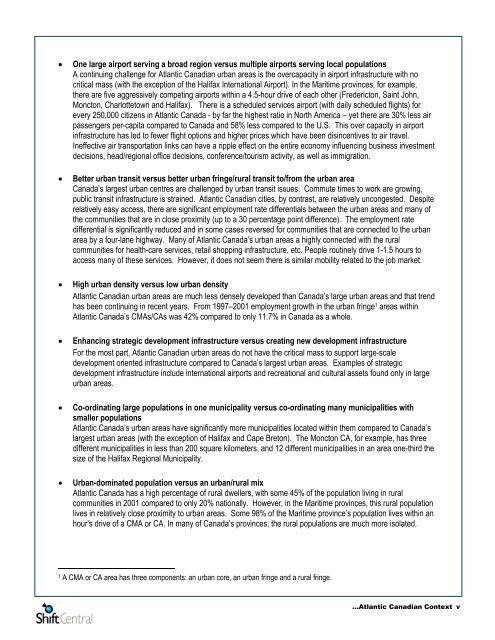Atlantic Canada's Urban Growth Agenda - Greater Halifax Partnership
Atlantic Canada's Urban Growth Agenda - Greater Halifax Partnership
Atlantic Canada's Urban Growth Agenda - Greater Halifax Partnership
You also want an ePaper? Increase the reach of your titles
YUMPU automatically turns print PDFs into web optimized ePapers that Google loves.
• One large airport serving a broad region versus multiple airports serving local populations<br />
A continuing challenge for <strong>Atlantic</strong> Canadian urban areas is the overcapacity in airport infrastructure with no<br />
critical mass (with the exception of the <strong>Halifax</strong> International Airport). In the Maritime provinces, for example,<br />
there are five aggressively competing airports within a 4.5-hour drive of each other (Fredericton, Saint John,<br />
Moncton, Charlottetown and <strong>Halifax</strong>). There is a scheduled services airport (with daily scheduled flights) for<br />
every 250,000 citizens in <strong>Atlantic</strong> Canada - by far the highest ratio in North America – yet there are 30% less air<br />
passengers per-capita compared to Canada and 58% less compared to the U.S. This over capacity in airport<br />
infrastructure has led to fewer flight options and higher prices which have been disincentives to air travel.<br />
Ineffective air transportation links can have a ripple effect on the entire economy influencing business investment<br />
decisions, head/regional office decisions, conference/tourism activity, as well as immigration.<br />
• Better urban transit versus better urban fringe/rural transit to/from the urban area<br />
Canada’s largest urban centres are challenged by urban transit issues. Commute times to work are growing,<br />
public transit infrastructure is strained. <strong>Atlantic</strong> Canadian cities, by contrast, are relatively uncongested. Despite<br />
relatively easy access, there are significant employment rate differentials between the urban areas and many of<br />
the communities that are in close proximity (up to a 30 percentage point difference). The employment rate<br />
differential is significantly reduced and in some cases reversed for communities that are connected to the urban<br />
area by a four-lane highway. Many of <strong>Atlantic</strong> Canada’s urban areas a highly connected with the rural<br />
communities for health-care services, retail shopping infrastructure, etc. People routinely drive 1-1.5 hours to<br />
access many of these services. However, it does not seem there is similar mobility related to the job market.<br />
• High urban density versus low urban density<br />
<strong>Atlantic</strong> Canadian urban areas are much less densely developed than Canada’s large urban areas and that trend<br />
has been continuing in recent years. From 1997–2001 employment growth in the urban fringe 1 areas within<br />
<strong>Atlantic</strong> Canada’s CMAs/CAs was 42% compared to only 11.7% in Canada as a whole.<br />
• Enhancing strategic development infrastructure versus creating new development infrastructure<br />
For the most part, <strong>Atlantic</strong> Canadian urban areas do not have the critical mass to support large-scale<br />
development oriented infrastructure compared to Canada’s largest urban areas. Examples of strategic<br />
development infrastructure include international airports and recreational and cultural assets found only in large<br />
urban areas.<br />
• Co-ordinating large populations in one municipality versus co-ordinating many municipalities with<br />
smaller populations<br />
<strong>Atlantic</strong> Canada’s urban areas have significantly more municipalities located within them compared to Canada’s<br />
largest urban areas (with the exception of <strong>Halifax</strong> and Cape Breton). The Moncton CA, for example, has three<br />
different municipalities in less than 200 square kilometers, and 12 different municipalities in an area one-third the<br />
size of the <strong>Halifax</strong> Regional Municipality.<br />
• <strong>Urban</strong>-dominated population versus an urban/rural mix<br />
<strong>Atlantic</strong> Canada has a high percentage of rural dwellers, with some 45% of the population living in rural<br />
communities in 2001 compared to only 20% nationally. However, in the Maritime provinces, this rural population<br />
lives in relatively close proximity to urban areas. Some 98% of the Maritime province’s population lives within an<br />
hour’s drive of a CMA or CA. In many of Canada’s provinces, the rural populations are much more isolated.<br />
1 A CMA or CA area has three components: an urban core, an urban fringe and a rural fringe.<br />
…<strong>Atlantic</strong> Canadian Context v





